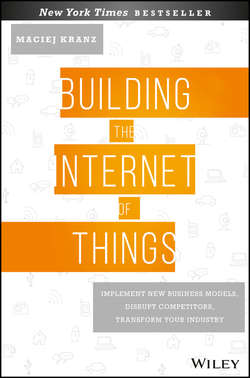Читать книгу Building the Internet of Things - Kranz Maciej - Страница 6
На сайте Литреса книга снята с продажи.
Part 1
A Secure and Transformative IoT Now
1
Beyond the Hype – All You Actually Need to Know About IoT for Business
A Revolutionary Economic Opportunity
ОглавлениеMany of us view IoT as the next stage of the Internet/Web that uses the Internet protocol–based (IP-based) distributed cloud to connect anything to anything. According to Vernon Turner, senior vice president of enterprise systems and IDC Fellow for The Internet of Things, “Think of IoT as a network of uniquely identifiable things that communicate using IP connectivity without human interaction.” Pretty straightforward, huh? Some people, including me, extend this definition into what some call the Internet of Everything (IoE), a term first coined by Cisco, or even to the digitization of smart assets. IoE brings together the people, processes, data, and things that make networked connections more relevant by turning information into actions. For the purposes of simplicity and clarity, this book refers to both IoE and IoT as IoT – in effect, treating the two terms as synonymous.
Here's an easy way to think of what's going on: The first stage of the Internet connected people to networks, data, each other, and processes. With IoT, we're now connecting anything with anything – or, if you prefer, everything with everything. In short, anything that can be digitized can be part of IoT. The business impact of IoT makes it revolutionary; when everything can communicate with everything else, it essentially redefines and creates new business value chains (see Figure 1.3).
Figure 1.3 First Two Stages of the Internet
First, as Turner points out, IoT disrupts traditional value chains. This forces companies to rethink and retool everything they do, including product design, production, marketing, and after-sales service, while using analytics combined with security. That's essentially what happened at Harley-Davidson. From there, smart connected products expand traditional B2B channels and effectively demolish line-of-business (LOB) boundaries.
A decade ago, visionaries talked about mass customization – the ability to customize mass-produced products to each individual buyer's specifications. A few tried, but it proved very difficult to implement efficiently. The process had too much latency (delay), which added cost and slowed the results. However, IoT makes strategies like mass customization far more practical and cost efficient. Latency isn't a problem. Information can be shared in real time between every element in the supply chain. Buyers can click on the components they want. Suppliers and logistics providers can see what components are being ordered, and with rapid systems retooling adjust their schedules appropriately – on the fly, if necessary. With the information flowing, the various players can ensure the desired components are at the production line when that customer's order is being assembled, whether it's a car or a three-piece suit. Customers order a car or a suit or anything else, specify the desired components, and have it built or assembled as ordered. Daihatsu Motor Company is already using 3D printers to offer its car buyers 10 colors and 15 base patterns to create their own “effect skins” for the car exterior. Each order rolls off the assembly line customized to that individual buyer. And it's no big deal. With IoT, mass customization is starting to happen.
Now imagine what's possible when you can connect anything with anything – production lines with parts and components, production lines with suppliers, products with service providers, logistics operations with transportation companies – and you can do it in near–real time. Designers could create products people really want and use, marketers could sell those products the way people want them, and service and support teams would know where potential problems are and address them before things break. Costs could be contained, and customer satisfaction would soar.
Or imagine if products you put out in the field could link back to you, signaling when a part starts to fail or a configuration isn't working correctly. You could effectively eliminate unplanned downtime. What could product managers do when they learned that customers were using the company's product in new ways the marketing teams didn't even imagine? The possibilities and opportunities are endless. Admittedly, not all of these concepts and value propositions are available at scale today, but there are plenty of mature, fast paybacks you can implement now.
At the same time, there is no magic here. That's right; no magic is at play, none, nada. We're talking about the same digitally connected world we know now, just more so. Essentially, we're using the cloud as we know it, plus an intelligent infrastructure within which every device is digitized and addressable over a common IP network. Yes, there are a few new innovations – such as fog computing, a form of cloud computing at the edge of the network for real-time data processing; blockchain technology, essentially a secure distributed log; and machine learning, the technology behind real-time predictive analytics – but none of these is magic either. These are concepts that industry is focusing on and implementing (if you can't wait to learn more about them, we will cover them in more detail in Chapter 10); nothing exotic, nothing magical.
